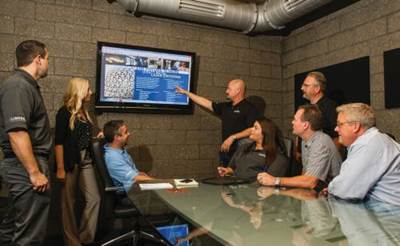Reshaping Moldmaking
Metal-printed components like conformal cooling inserts can improve existing production processes.
Linear Mold & Engineering added 3D metal printing to its repertoire of moldmaking and engineering capabilities a number of years ago. Moog Inc., a designer, manufacturer and integrator of precision motion control products and systems, also had been exploring additive manufacturing. The recent acquisition of Linear by Moog can be seen not only as a strong indication of how the market for additive manufacturing continues to heat up, but also as a sign of how materials science and production capabilities continue to evolve.
The renamed Linear AMS is finding that Moog’s engineering expertise helps make qualifying of new materials like tool steels more efficient, and getting new material into production more quickly helps customers improve their production operations. This is particularly true of the company’s additively grown conformal cooling inserts for injection molders.
A growing number of service bureaus print 3D plastic and metal parts capable of replacing machined components. Linear AMS produces molds and castings with 3D-printed components made from emerging metal materials that the company says can improve production processes and help reduce cycle times by as much as 25 to 30 percent.
Building Conformal Cooling Inserts
Additively grown conformal cooling channels in production molds are a powerful example of how additive technology is reshaping moldmaking. The term conformal relates to how the 3D metal-printed cooling channels follow, or conform to, the part shape and surface. The layer-by-layer building by direct laser melting results in geometries virtually impossible for conventional machining.
The process of building conformal cooling inserts can be generally broken up into four steps: 1) simulating the molding process, 2) insert design and optimization, 3) 3D direct metal laser melting, and 4) post processing. Simulation software in the first step allows tool designers to visualize flow capabilities and thermal properties that can cause mold deformation prior to actual production. Cavity block or core block inserts then can be designed with conformal water lines in place, based on simulation results. The layer-by-layer 3D-printing that comes next not only can be completed in a number of materials that match conventional tool steels, but the resulting built-in channels will exhibit outstanding geometric flexibility. Post-processing tasks include stress relief and heat treatment, using EDM to machine the part from its platform base, polishing the part surface, adding water lines, and inspection.
The Results
Thermal channels that conform to a part’s shape and surfaces allow for more even heating and cooling. The less temperature variation over a part’s surface during molding, the more it will hold its shape. In addition to reduced warpage, eliminating hot and cold spots with improved placement of thermal lines should produce a part much closer to the CAD model, in which sinks, voids and stresses are greatly reduced if not eliminated. A more uniform temperature throughout the part also means a much shorter cooling cycle, as the cooling stage is almost all about getting temperatures to even out.
Conformal cooling inserts are particularly useful in areas of molds to which water can’t easily be delivered, such as targeted hot spots, inserted thin-steel conditions, slide faces and lifter bodies. Best-fit applications for conformal cooling in injection molding include: structural components normally designed with thick wall conditions and made from engineered resins with high melt temperatures; handles designed to withstand high load conditions; parts with high scrap rates due to warping and dimensional issues; any part where the cooling portion is more than 20 percent of the overall cycle time; and high-volume parts, because even small improvements in cycle time or quality can mean great improvements in capacity and profitability.
Take, for example, an order for what are called “banana core” molded door handles. The customer was facing total failure after 12 shots, as the tip of the part reached 300°F. After the design was altered to include conformal cooling lines in the mold core that easily extended to the curved tip and cooled the entire length of the part, the core temperature remained steady at 72°F through 11 hours of production. Process time was reduced from 35 seconds to 16 seconds, saving roughly 76 days over a production run of 350,000 parts.
Process improvements that can be gained from the addition of additively built conformal cooling inserts in molds don’t necessarily take away from subtractive manufacturing’s role in traditional mold building. In fact, this may be the perfect example of how well additive and subtractive technologies can be integrated so that moldmakers and molders can best take advantage of both.
Related Content
Treatment and Disposal of Used Metalworking Fluids
With greater emphasis on fluid longevity and fluid recycling, it is important to remember that water-based metalworking fluids are “consumable” and have a finite life.
Read MoreHands-on Workshop Teaches Mold Maintenance Process
Intensive workshop teaches the process of mold maintenance to help put an end to the firefighting culture of many toolrooms.
Read MoreRevisiting Some Hot Runner Fundamentals
What exactly does a hot runner do? If you’ve been in the injection molding industry for any length of time, you might think the answer is obvious, but it is not.
Read More6 Ways to Optimize High-Feed Milling
High-feed milling can significantly outweigh potential reliability challenges. Consider these six strategies in order to make high-feed milling successful for your business.
Read MoreRead Next
Cracking the Code to Growth in AM
It takes more than machines on the shop floor to push additive manufacturing to the next level. According to one manufacturer, it takes customer service, education and training, too.
Read MoreReasons to Use Fiber Lasers for Mold Cleaning
Fiber lasers offer a simplicity, speed, control and portability, minimizing mold cleaning risks.
Read MoreHow to Use Continuing Education to Remain Competitive in Moldmaking
Continued training helps moldmakers make tooling decisions and properly use the latest cutting tool to efficiently machine high-quality molds.
Read More























